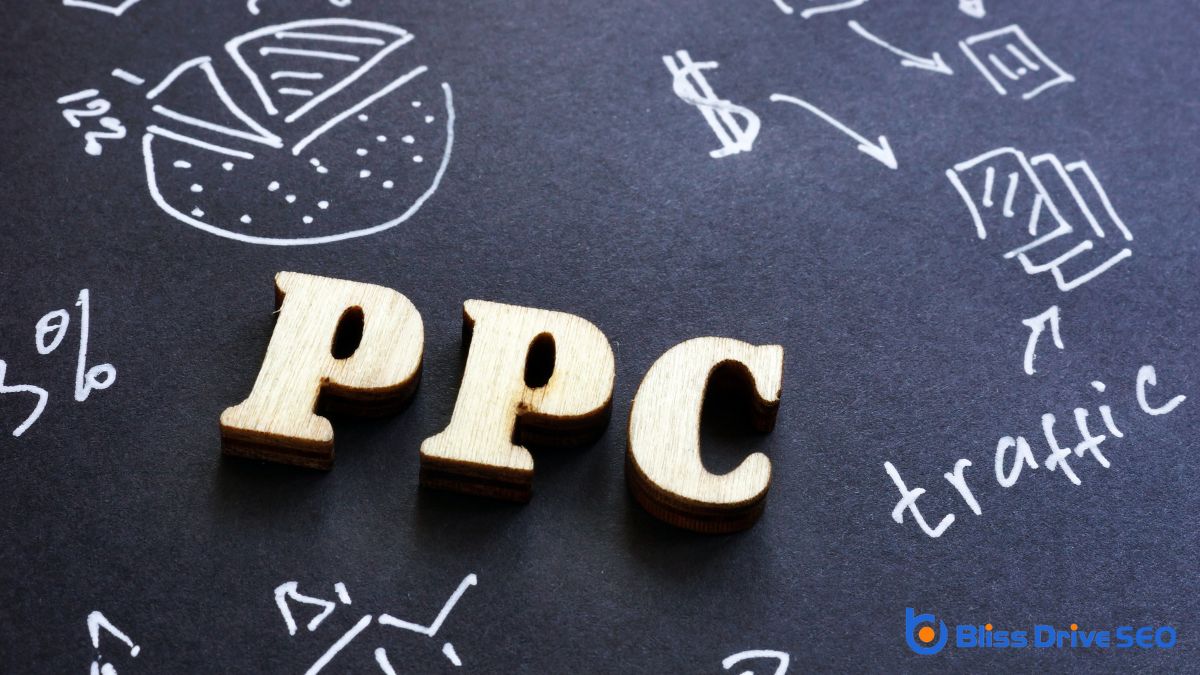Digital Marketing Services
Learn More About Us

Pay-per-click (PPC)An online advertising model where advertisers pay a fee each time their ad is clicked. advertising can be highly profitable if you target the right audience and optimize your campaigns with key performance metricsKey indicators used to measure the effectiveness of affiliate marketing efforts, such as clicks, con... in mind. To guarantee success, align your ad spending with crystal-clear business goals. Understanding metrics like click-through rate, conversion rateThe percentage of visitors who complete a desired action, such as making a purchase or filling out a..., and cost per acquisition is essential. By mastering these elements and regularly refining your approach, you'll maximize returns. Ready to access new opportunities and boost your marketing prowess?

When you immerse yourself in the world of Pay-Per-Click (PPC) advertising, you'll find it's a model where advertisers pay a fee each time their ad is clicked.
It's fundamentally a way of buying visits to your site rather than earning them organically. You select keywords relevant to your business, and when users search for those terms, your ad appears. By strategically choosing keywordsWords or phrases that users type into search engines to find information. and crafting compelling ads, you can target potential customers effectively.
In PPC, platforms like Google Ads auction ad placementsSpecific websites or locations within websites where ads can appear.. Your ad's visibility depends on factors like bid amount and ad quality.
If you master these elements, PPC can drive significant traffic to your website. It's a dynamic environment, offering you the chance to reach your audience precisely when they're interested.
To truly harness the power of PPC advertising, you need to focus on key metrics that gauge the effectiveness of your campaigns.
Start by tracking click-through rate (CTR)The percentage of users who click on a specific link or CTA., which reveals how well your ads attract attention. A high CTR indicates engaging content.
Next, monitor the conversion rate to determine how many clicks turn into valuable actions, like purchases.
Cost per acquisition (CPA) is essential, too—it tells you how much you're spending to gain a new customer.
Finally, keep an eye on return on ad spend (ROAS)A metric that measures the revenue generated for every dollar spent on advertising. to see if your investment is paying off.
By understanding these metrics, you'll make informed decisions, optimize your campaigns, and guarantee your PPC efforts drive profitable results.
Stay data-driven, and you'll succeed.
How do you decide which PPC platform is right for your business? Start by identifying where your audience spends their time online. If they're on social media, platforms like FacebookA social networking site where users can post comments, share photographs, and links to news or othe... or InstagramA photo and video-sharing social networking service owned by Facebook. might be ideal.
For a broader reach, Google Ads can connect you with users searching for your products. Consider your industry, too—LinkedIn is perfect for B2B, while PinterestA visual discovery and bookmarking platform where users can find and save ideas. suits visual-centric businesses.
Next, evaluate the platform's features and targeting options. Some platforms offerThe specific product or service being promoted by affiliates. more precise targeting, helping you reach your specific audience.
Don't forget to check the competition on each platform; high competition might increase costs.
Finally, align your choice with your business goals. Whether you're looking for brand awarenessThe extent to which consumers are familiar with the qualities or image of a particular brand. or direct sales, select a platform that supports your objectives.
To set a realistic budget for your PPC campaigns, start by defining clear campaign objectives that align with your business goals.
Next, keep an eye on your competitors' spending to understand the market landscape and identify opportunities.
Finally, optimize your cost-per-click to guarantee you're getting the most value without overspending.
Why is setting a realistic budget essential for a successful PPC campaign? It guarantees you maximize returns without overspending.
Begin by clearly defining your campaign objectives. Are you looking to increase brand awareness, drive website traffic, or boost sales? Knowing your goals helps guide your budget decisions.
Next, assess your target audience. Understand their behavior and preferences to allocate funds effectively. Remember, a well-defined audience reduces wasteful spending.
Set a daily or monthly budget that aligns with your objectives and market conditions.
Keep in mind that flexibility is key. Monitor performance and adjust your budget as necessary to capitalize on successful strategies.
Understanding competitor spending is essential when setting a realistic budget for your PPC campaigns. By analyzing how much your competitors invest, you gain valuable insights into the industry standards and expectations.
Start by identifying your main competitors and using tools like SEMrush or SpyFu to uncover their spending patterns. Look at their keyword bids, ad placements, and overall strategy.
Don't just mimic their budget—consider your unique goals, resources, and market position. Pinpointing whether they're overspending or underspending can guide your decisions.
This research helps you avoid blindly following trends and instead craft a budget that balances competitiveness with financial prudence.
When optimizing your cost-per-click (CPC) for PPC campaigns, it's essential to set a realistic budget that aligns with your marketing goals and financial capacity.
Start by understanding your target audience and what they're willing to pay attention to. Research keyword costs thoroughly to avoid overspending. Use tools like Google Keyword Planner to gauge average CPCs for relevant terms.
Don't forget to monitor your campaign's performance regularly. Adjust your bids based on what's working and what's not. This flexibility guarantees you're not wasting money on ineffective strategies.
Prioritize high-converting keywords to maximize your return on investment.
To make your pay-per-click campaigns profitable, start by crafting headlines that grab attention and speak directly to your audience's needs.
Pair these with effective call-to-action phrases that motivate clicks and conversions.
Don't underestimate the power of visual elements—use images or videos that enhance your message and capture your audience's interest.
How do you make your ad stand out in a sea of digital noise? Crafting an intriguing headline is your first shot at grabbing attention.
It's your chance to spark curiosity and invite clicks. To create headlines that enthrall, consider these techniques:
Incorporate these strategies to enhance your headlines and elevate your pay-per-click campaigns.
After capturing your audience's attention with an engaging headline, the next step is guiding them toward action with an effective call-to-action (CTA). Crafting a compelling CTA involves clear language and urgency, encouraging immediate interaction. It should be direct and relevant, driving users to click through. Consider using action-oriented verbs that resonate with your audience's needs.
Here's a quick guide to effective CTAs:
| CTA Phrase | Purpose |
|---|---|
| "Shop Now" | Urges immediate buy |
| "Get Started" | Encourages exploration |
| "Claim Your Offer" | Highlights exclusivity |
Each phrase should match the ad's intent and target audience. Test different CTAs to see which resonates best. Remember, an effective CTA bridges the gap between interest and conversion, making your pay-per-click efforts more profitable.
When crafting compelling ad copy and creativity, the impact of visual elements can't be overstated. They grab your audience's attention and communicate your message quickly.
Think of visuals as the hook that reels potential customers in. To make your ads stand out, consider these essential elements:
Reaching the right audience is essential for maximizing the impact of your pay-per-click campaigns. You've got to know who your ideal customers are to tailor your ads effectively.
Start by defining your target audience based on demographics like age, gender, and location. Dive deeper by considering their interests, behaviors, and search habits.
Use tools like Google Ads' Audience Insights to understand your audience better. This helps you create precise targeting strategies, ensuring your ads reach those most likely to convert.
Don't forget about using negative keywordsKeywords that prevent ads from being shown for certain search queries. to filter out irrelevant clicks, saving you money.
Effective targeting sets the stage, but the real game-changer in pay-per-click success is analyzing and optimizing your campaign performance. When you examine the data, you uncover insights that can greatly boost your results.
Start by monitoring key metrics like click-through rates, conversion rates, and cost per conversion. These numbers tell you what's working and what's not. Be proactive in making adjustments, such as tweaking ad copy or refining keywords.
Consider these strategies to enhance your PPC campaigns:
These steps will help you maximize your PPC efforts.

Understanding the return on investment (ROI)A measure of the profitability of an investment, calculated by dividing the net profit by the cost o... for your PPC efforts is essential for determining the true value of your campaigns.
Begin by comparing the revenue generated from PPC against the costs incurred. Calculate ROI by subtracting the cost from the revenue, then dividing by the cost and multiplying by 100 for a percentage.
Monitor key metrics like click-through rates, conversion rates, and customer acquisition costs. These indicators help you identify which ads are performing well and where adjustments are needed.
Don't forget to take into account the lifetime value of a customer, not just immediate sales.
Regularly assess your PPC ROI to guarantee your campaigns are profitable and aligned with your business goals.
This process helps you allocate budgets effectively and maximize your marketing impact.
In the world of digital marketing, pay-per-click can be a profitable strategy if done right. By understanding the basics and focusing on key metrics, you'll make informed decisions about the best platforms for your business. Set a realistic budget, craft compelling ad copy, and target the right audience to maximize impact. Always analyze and optimize your campaigns for the best results. With careful planning, you'll see a solid return on investment from your PPC efforts.
